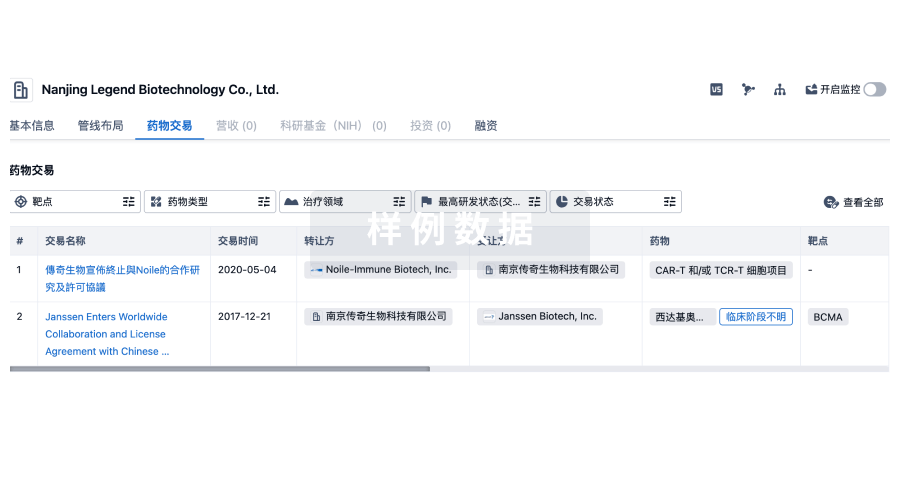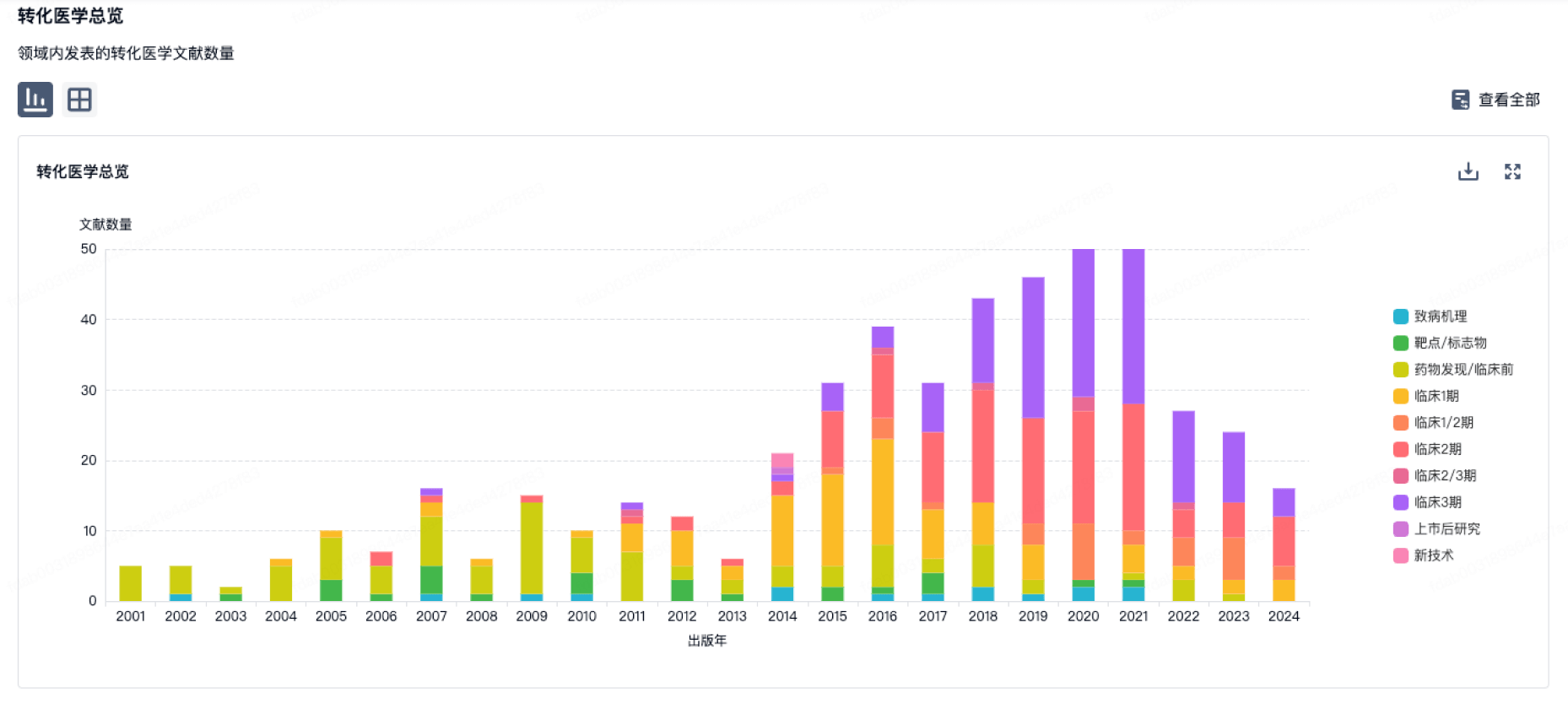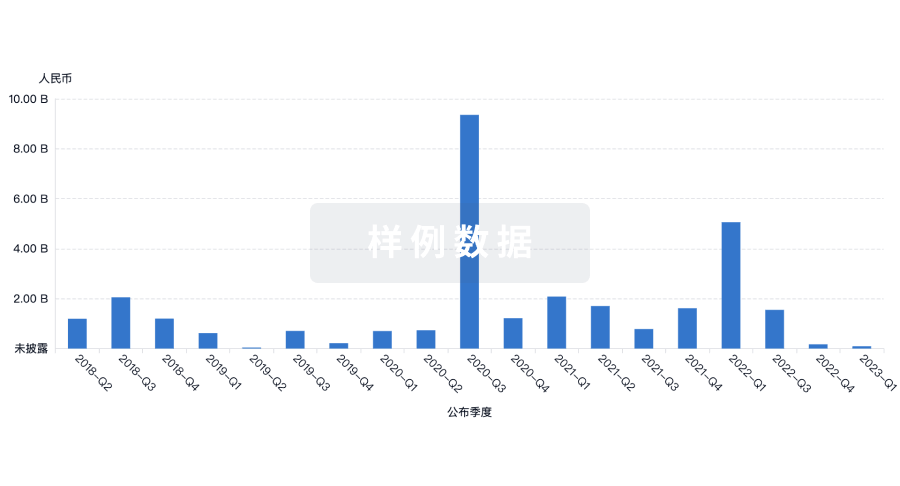预约演示
更新于:2025-10-31

Inner Mongolia Agricultural University
更新于:2025-10-31
概览
标签
感染
泌尿生殖系统疾病
内分泌与代谢疾病
小分子化药
化学药
多糖药物
疾病领域得分
一眼洞穿机构专注的疾病领域
暂无数据
技术平台
公司药物应用最多的技术
暂无数据
靶点
公司最常开发的靶点
暂无数据
| 排名前五的药物类型 | 数量 |
|---|---|
| 小分子化药 | 1 |
| 化学药 | 1 |
| 多糖药物 | 1 |
| 排名前五的靶点 | 数量 |
|---|---|
| Bacterial proteins(细菌蛋白) | 1 |
关联
2
项与 内蒙古农业大学 相关的药物作用机制 细菌蛋白抑制剂 [+1] |
在研机构 |
原研机构 |
在研适应症 |
非在研适应症- |
最高研发阶段临床前 |
首次获批国家/地区- |
首次获批日期- |
5
项与 内蒙古农业大学 相关的临床试验ChiCTR2500102692
A randomized, double-blind, placebo-parallel controlled trial of probiotics to promote growth in children
开始日期2025-05-20 |
申办/合作机构  内蒙古农业大学 内蒙古农业大学 [+1] |
ChiCTR2500106261
A randomized, double-blind, placebo-controlled trial on the effects of compound probiotics combined with yeast peptides on gastrointestinal symptoms and athletic performance of athletes during training
开始日期2022-09-01 |
申办/合作机构  内蒙古农业大学 内蒙古农业大学 [+2] |
ChiCTR2100054420
The protection of intestinal barrier function and reduction of inflammatory response by compound probiotics in patients with liver cirrhosis: a randomized, double-blind controlled study
开始日期2022-01-01 |
申办/合作机构 |
100 项与 内蒙古农业大学 相关的临床结果
登录后查看更多信息
0 项与 内蒙古农业大学 相关的专利(医药)
登录后查看更多信息
4,214
项与 内蒙古农业大学 相关的文献(医药)2026-01-01·THERIOGENOLOGY
Cyclic guanosine monophosphate (cGMP) improves freezing tolerance of sheep embryos by reducing lipid content
Article
作者: Sun, Wui ; Song, Yukun ; Guo, Yaxin ; Sun, Yupeng ; Zhao, Cun ; Zhang, Jiaxin ; Zhang, Nan ; Wang, Zhiying
Embryos produced in vitro exhibit heightened cryosensitivity due to excessive lipid accumulation. Previous studies demonstrated that cyclic guanosine monophosphate (cGMP) modulates intracellular lipid metabolism through cGMP-dependent protein kinase (PKG) signaling in various cell types. This study investigated the effects of cGMP on (i) cryosurvival in sheep embryos, (ii) embryonic quality, and (iii)lipolysis-related parameters. Specifically, we quantified lipid droplet content, free fatty acid levels, and hormone-sensitive lipase (HSL) phosphorylation status as key indicators of lipolytic activity. The results showed that cGMP pretreatment (0.5 mM) for 10 min prior to slow freezing significantly improved post-thaw embryo recovery rates and upregulated the mRNA expression of key developmental genes (POU5F1, SOX2, CDX2, and NANOG). cGMP pretreatment significantly upregulated the expression of multiple lipid catabolism genes (ACSL4, HMGCR, HMGCS1, LIPE, LPL, LIPF, and PLIN2), with LIPE (encoding HSL) exhibiting the most pronounced induction (27.10-fold increase vs. control). Following cGMP pretreatment, PKG activation triggered significant increases in the intracellular Ca2+ level and Calcium/Calmodulin-dependent Protein Kinase II (CaMKII) phosphorylation. Given HSL's established sensitivity to calcium fluctuations, this cascade led to markedly enhanced HSL phosphorylation. Concurrently, blastocysts exhibited a significant reduction in lipid droplet content, while transient fatty acid accumulation was observed due to enhanced HSL activity. In summary, pretreating sheep blastocysts with cGMP prior to slow freezing notably elevates their cryotolerance. This enhancement is achieved by triggering the lipolytic activity of HSL via the PKG/CaMKII/Ca2+ signaling cascade. This pathway specificity underscores cGMP's potential as a targeted cryoprotectant adjuvant for assisted reproductive technologies, particularly for improving the cryosurvival of lipid-rich embryos.
2026-01-01·THERIOGENOLOGY
Targeting the mPGES-PGE2-EP4 pathway with MF63, MK886, and Grapiprant as a potential therapeutic strategy for Escherichia coli-induced endometritis in dairy cows
Article
作者: Gong, Pengfei ; Zhang, Shuangyi ; Mao, Wei ; Yang, Xiaolin ; Wu, Jingze ; Guo, Lili ; Guo, Wenrui ; Cao, Jinshan ; Feng, Shuang ; Qian, Yinghong
Escherichia coli (E. coli) is the primary causative agent of endometritis in dairy cows. Antibiotics and non-steroidal anti-inflammatory drugs (NSAIDs) are the main treatments; however, prolonged antibiotic use promotes bacterial resistance, while NSAIDs can delay ovulation and impair reproduction. Safer and more effective alternative therapies are needed to control infection while minimizing adverse effects. In the bovine uterine microenvironment, prostaglandin E2 (PGE2) plays a key role by activating the EP4 receptor. However, the therapeutic potential of microsomal prostaglandin E synthase-1 (mPGES-1) inhibitor (MF63), mPGES-1 regulator (MK886) and the EP4 receptor antagonist (Grapiprant) in bacterial endometritis remains unclear. This study investigates the therapeutic potential of MF63, MK886 and Grapiprant in mitigating E. coli-induced endometritis in dairy cow. Molecular docking showed that MF63 and MK886 efficiently bind to mPGES-1, while Grapiprant stably binds to the EP4 receptor. Additionally, these inhibitors significantly suppressed PGE2 secretion in E. coli-infected bovine endometrial tissues. Hematoxylin and eosin staining and immunofluorescence analysis demonstrated that MF63, MK886, and Grapiprant significantly reduced E. coli-induced tissue damage and the expression of damage-associated molecular patterns, such as HMGB-1 and HABP-2. Furthermore, these treatments decreased pro-inflammatory cytokines (TNF-α, IL-6, IL-1β) and the chemokine IL-8 while increasing IL-10 expression. In conclusion, targeting the mPGES-PGE2-EP4 pathway may offer a safer, more effective alternative for managing E. coli-induced endometritis in dairy cows.
2026-01-01·Journal of Environmental Sciences
Contrastive mechanisms of lacustrine groundwater discharge and associated pollutant fluxes into two typical inland lakes in Inner Mongolia, Northwest China
Article
作者: Wang, Juliang ; Zhao, Yuanzhen ; Zhang, Keyi ; Liao, Fu ; Li, Muhan ; Yu, Ruihong ; Ren, Xiaohui ; Qu, Shen
Lacustrine groundwater discharge (LGD) plays an important role in water resources management. Previous studies have focused on LGD process in a single lake, but the differences in LGD process within the same region have not been thoroughly investigated. In this study, multiple tracers (hydrochemistry, δD, δ18O and 222Rn) were used to compare mechanisms of LGD in Daihai and Ulansuhai Lake in Inner Mongolia, Northwest China. The hydrochemical types showed a trend from groundwater to lake water, indicating a hydraulic connection between them. In addition, the δD and δ18O values of sediment pore water were between the groundwater and lake water, indicating the LGD processes. The radon mass balance model was used to estimate the average groundwater discharge rates of Daihai and Ulansuhai Lake, which were 2.79 mm/day and 3.02 mm/day, respectively. The total nitrogen (TN), total phosphorus (TP), and fluoride inputs associated with LGD in Daihai Lake accounted for 97.52 %, 96.59 %, and 95.84 % of the total inputs, respectively. In contrast, TN, TP and fluoride inputs in Ulansuhai Lake were 53.56 %, 40.98 %, and 36.25 %, respectively. This indicates that the pollutant inputs associated with LGD posed a potential threat to the ecological stability of Daihai and Ulansuhai Lake. By comparison, the differences of LGD process and associated pollutant flux were controlled by hydrogeological conditions, lakebed permeability and human activities. This study provides a reference for water resources management in Daihai and Ulansuhai Lake basins while improving the understanding of LGD in the Yellow River basin.
11
项与 内蒙古农业大学 相关的新闻(医药)2025-08-12
·求实药社
中枢神经系统(CNS)一直是医学研发中最具挑战性的领域之一。从阿尔茨海默病到精神分裂症,从神经退行性疾病到罕见脑病,CNS 疾病不仅深刻影响患者生活质量,也持续推动全球医疗科技的创新突破。
为便于行业观察与交流,本文汇总整理了63位深耕CNS领域的企业创始人及CEO(排名不分先后)。所列信息来自公司官网及公开资料,如有更新滞后,敬请谅解。
本次为上篇,下篇将于近期发布。
1、Christophe Weber ,武田制药,代表董事 - 总裁兼首席执行官Christophe Weber是武田的总裁、首席执行官(CEO)兼代表董事。他于2014年4月加入公司担任首席运营官,于2014年6月被任命为总裁兼代表董事,随后于2015年4月被任命为首席执行官。Christophe一直致力于通过全球化和研发转型来确保公司的竞争力,同时创造多元化和包容性的工作环境,并加强武田的道德价值观和公司治理。通过这一转型,武田已成为全球领先的生物制药公司之一。
在加入武田之前,Christophe在葛兰素史克工作了20年,在欧洲、亚洲和美国担任高级领导职务。
Christophe 是美国商业理事会、世界经济论坛国际商业理事会、纽约证券交易所纽约证券交易所董事会咨询委员会、马萨诸塞州竞争伙伴关系董事会、麻省理工学院首席执行官顾问委员会和新加坡人类健康与潜力国际咨询委员会的成员。他还在东北大学董事会任职。
Christophe 拥有法国里昂大学药学和药代动力学博士学位、药品营销和会计与金融硕士学位以及统计学学位。
2、Robert A. Michael,艾伯维,董事会主席兼首席执行官
Rob Michael 是艾伯维的董事会主席兼首席执行官,艾伯维是一家全球生物制药公司,在全球拥有约 55,000 名员工,已为超过 175 个国家/地区的 6000 多万人提供创新药物和产品。
Michael 先生于 2024 年被任命为首席执行官,此前曾担任艾伯维总裁兼首席运营官,并且一直是艾伯维执行领导团队的长期成员。从建立艾伯维的第一个财务规划组织,到制定其多元化业务战略,再到在美国修美乐失去独家经营权后的两年内成功使公司恢复收入峰值,迈克尔先生多年来一直是艾伯维成功和发展不可或缺的一部分。在担任总裁兼首席运营官期间,Michael 先生负责公司的全球商业运营、财务、企业人力资源、全球运营、业务发展和企业战略。他曾于 2022 年被任命为副董事长兼总裁,于 2021 年被任命为财务和商业运营副董事长,并于 2018 年被任命为首席财务官。Michael 先生拥有 30 多年的经验,包括在制药、美容、诊断、糖尿病护理和营养等多个业务中担任领导职务。他的职业生涯始于雅培,是金融发展计划的成员。
Michael先生在印第安纳大学凯利商学院获得会计学学士学位,在加州大学洛杉矶分校安德森管理学院获得工商管理硕士学位。
3、包杨欢,普百思生物创始人、CEO
创建普百思生物,并带领团队建立大数据驱动的、针对精准患者亚群的CNS“靶向疗法” 技术平台和管线。
归国前,曾在美国冷泉港实验室神经生物学系从事CNS疾病分子遗传学研究多年,并参与创立和运营一家CNS药物研发服务公司。
参与投资30余家生物医药医疗公司,其中包括天使轮或者第一次机构投资纳微科技、纽福斯、康立明生物、优脑银河等。
4、蔡宇伽,本导基因,创始人
基因治疗领域顶尖华人科学家,基因治疗载体技术专家,丹麦奥胡斯大学博士,中国生物工程学会系统生物医学专业委员会委员。长期从事基因治疗病毒载体、基因编辑递送技术的研发以及基因治疗载体与机体免疫系统互作的研究,致力于新技术的临床转化。
5、陈柏州,加立(深圳)生物科技有限公司,联合创始人兼首席执行官
陈柏州先生毕业于麻省理工学院,曾任职多家知名跨国药企,担任研发领导职位,包括新旭生技全球临床研发高级副总裁、联合生物制药公司总经理、PPD北亚区临床管理负责人等。
6、陈晨,璧辰医药,创始人兼CEO
陈晨博士是ABM的创始人和首席执行官。创建ABM之前,他曾担任桑迪亚的总经理,在任期间,公司从200多人发展到了500多人。陈晨博士拥有20多年在中枢神经药物研发方面的经验,其中包括在专注神经系统药物研发的纳斯达克上市公司Neurocrine Bioscience15年的工作经验。陈博士由研究员起步,直至升任该公司的药物化学高级研发主任, 并在新药发现领域取得了多项令人瞩目的成绩。他研发出两个促性腺激素释放激素受体小分子拮抗剂,NBI-42902和 Elagolix,并推进到临床研究。其中 Elagolix 是10多年来,FDA 批准的第一个治疗子宫内膜异位导致的中度到重度疼痛的口服药。
陈晨博士获得厦门大学化学学士学位,随后在中国科学院上海有机化学研究所师从已故黄耀曾院士并获得博士学位。在美国德克萨斯 A & M 大学他跟随诺贝尔化学奖获得者巴顿爵士进行博士后训练。陈博士已在《全美化学学报》、《有机化学学报》、《药物化学学报》、和《生物化学学报》等专业期刊发表了近130篇论文,也是25+项美国专利的共同发明者。
7、陈东浩,杭州畅溪制药,CEO
陈东浩博士在吸入产品开发与制药企业管理方面,拥有25+年的行业经验。
他是 AIR 的联合创始人兼创始科学家,后作为Alkermes的CMC负责人主导了两个早期临床阶段的吸入产品开发,包括与礼来合作开发的吸入胰岛素。2006至2010年,陈东浩博士加入一家位于美国波士顿的全球领先的RNAi公司——Alnylam,担任研发总监,领导建立 siRNA 给药平台,并作为项目负责人带领团队成功完成了世界首例吸入小核酸治疗RSV一期临床实验。随后,陈东浩博士回到中国,出任 Chemo集团(中国)公司总经理,积累了丰富的全面管理,及与国家法规机构沟通的实践经验。
陈东浩博士于1997年获得瑞士苏黎世联邦理工学院(ETH-Zurich)授予的博士学位,并作为访问学者于1998到2000在麻省理工学院 Langer's实验室工作。
8、陈功,神曦生物,创始人、董事长
陈功教授是国家特聘专家,海外高层次人才(A类大千),暨南大学粤港澳中枢神经再生研究院大脑修复中心主任。1987年毕业于复旦大学,1993年获得中科院上海生理所神经生物学博士。1994年赴美国耶鲁大学和斯坦福大学做博士后研究。自2002年起历任宾夕法尼亚州立大学助理教授,副教授(终身教授),正教授,2013年被授予维恩 魏勒曼冠名主任教授(讲席教授)。2020年全职加入暨南大学,担任大脑修复中心主任,推动大脑原位神经再生技术向临床应用的转化。陈功教授领导的团队在国际上首次报导了用神经转录因子NeuroD1将大脑内源性胶质细胞原位高效地转化为功能性神经元这一里程碑工作,被干细胞顶尖杂志Cell Stem Cell评为2014年度最佳论文,为大脑修复开辟了全新的神经再生型基因疗法。2015年再次在Cell Stem Cell上发表小分子化合物诱导培养的人源胶质细胞高效转化为功能性神经元的工作,为开发利用脑内胶质细胞再生神经元的药物疗法奠定了基础。2020年又在国际上首次发表灵长类大脑原位神经再生的里程碑工作。
陈功教授已经获得58项国内国际发明专利授权,覆盖中国,美国,欧盟,日本等主要经济体国家。2021年,陈功教授创办的NeuExcell神曦生物与国际著名药企罗氏制药旗下的Spark达成合作协议。2023年,神曦生物被国际权威机构沙利文授予“亚太基因治疗创新奖”,同年获得全国创新创业大赛总决赛一等奖。2024年,神曦生物的胶质瘤基因治疗产品NXL-004成功完成全球首例恶性胶质瘤患者的NeuroD1 AAV基因治疗给药,实现从基础研究到临床转化的0到1的突破。2025年3月和4月,又相继启动了全球领先的 First-in-Class 原位神经再生疗法治疗脑卒中和阿尔兹海默症的临床试验,为千千万万的患者带来福音。
9、陈泓恺,安立玺荣生物医药,CEO
陈泓恺博士为安立玺荣生医创办人,身兼董事长及执行长,执掌公司营运管理事务及发展策略方向,具有多年於国际药厂新药开发经验,专长于创新型药物之转译医学研究及临床前到临床开发。
在创立安立玺荣生医之前陈博士曾任职於雅祥生技医药股份有限公司担任资深副总裁兼医务长,领导治疗神经疾病新药之临床开发。在此之前曾任职於生物技术开发中心担任转译医学主任,建立跨领域转译医学平台并主导多项肿瘤免疫新药开发计画包括PD-L1及TIM3免疫检查点抑制剂单株抗体及CSF -1R小分子抑制剂等及双特异性抗体开发计划。在此之前陈博士任职於跨国大型药企葛兰素史克(GlaxoSmithKline)上海研发中心,担任神经免疫疾病研究部主任研究员。
期间建立人类干细胞分化神经元高通量药物筛选平台,并主持数项神经免疫疾病之新药开发项目并参与脑中风抗体新药第二期人体临床试验。在加入葛兰素史克之前,陈博士任职於美国加州大学旧金山分校所属格拉斯通研究所转化研究中心担任助理研究员,其间与美国默克药厂合作进行阿兹海默症新药研发,并发现ApoE4造成神经元粒线体功能缺失之分子机制,建立神经元粒线体功能筛选平台,开发出高效调节ApoE4功能之前导药物。
在此之前陈博士曾任职於阳明大学微生物及免疫学研究所助理教授。 陈博士为阳明大学医学士及微生物及免疫学博士,曾於美国贝勒医学院人类分子遗传学研究所博士后进修,并担任霍华德休斯医学研究所博士后研究员。有多项研究发明成果曾发表在包括Cell, Nature Medicine,Nature Communications等国际顶尖科学期刊。
10、陈小祥,元羿生物,创始人,CEO
陈小祥先生在生物医药行业有超过25年的经验,聚焦创新治疗的临床转化和开发,在多家企业成功创建临床研发团队,包括惠氏、勃林格殷格翰和和铂医药。他带领团队成功完成临床开发和法规注册,先后将超过20 种创新药物引入到中国市场。
加入元羿生物前,陈小祥先生自2017年起作为联合创始人参与创建和铂医药,并作为首席开发官全面负责公司的产品研发,包括临床前、CMC、临床开发和法规注册直至产品获批上市。在这之前,陈小祥先生在德国勃林格殷格翰公司曾经分别担任过大中华区以及新兴市场副总裁、医学主管,全面负责在地区内所有国家,包括临床开发、注册法规、医学事务、生物数据管理等等医学研发相关工作。在加入勃林格殷格翰前,陈小祥先生在美国惠氏制药长达12年的工作期间,分别担任过大中华区医学总监、亚太临床开发总监以及中枢神经领域的全球医学监察员等职务。
陈小祥先生从南京医科大学获得临床医学学位。
11、崔霁松,诺诚健华,联合创始人&董事会主席兼首席执行官
• 逾30年医药行业研发和公司管理经验
• 曾任PPD公司BioDuro的首席执行官兼首席科学官
• 默克美国心血管疾病早期开发团队负责人
• 霍华德休斯医学研究所博士后
• 普渡大学分子生物学博士
• 美中医药开发协会(SAPA)第17届主席
12、代红久,南京凯地生物,联合创始人、董事长&CEO
代红久博士为南京凯地医疗技术有限公司创始人、总裁兼董事长。代红久博士以第一发明人身份申报实体瘤CAR相关中美专利数十件,其中授权中美专利15件,2007年代红久博士取得中国科学院研究生院博士学位,次年赴美从事与CAR-T相关的T细胞免疫、GPCR受体功能与癌症发生机理的博士后研究,2013回国加入金斯瑞,先后任高级研究员、部门总监。近年,代红久博士已在《Science》 《PNAS》《Cancer Immunology Research》《Journal for ImmunoTherapy of Cancer》等国际权威杂志发表论文8篇,待发表文章4篇。利用先进合成生物学CAR发现平台已成功开发多款自主知识产权新型实体瘤CAR-T管线,适应症涵盖结直肠癌、肝癌、胃癌、胰腺癌、胶质瘤等多种实体肿瘤,目前多个核心管线进入IIT临床和中美IND申报阶段,公司已完成近亿元融资,正在启动B轮融资。凯地医疗获得2022南京市“培育独角兽称号”并荣登“星耀榜--2021中国生物医药企业最具创新力50强及中国医药创新种子100强企业。
13、董良昶,上海汉都医药,联合创始人、首席科学家、董事长兼总经理
药物递送系统专家
控释制剂和材料科学专家
华盛顿大学生物医药工程博士,师从被誉为“生物材料之父”的美国工程院科学院院士 ProfAllanS.Hoffman全球控释学会(CRS)首届杰出研究生奖获得者
在ALZA和J&J担任技术高管(SeniorResearchFellow)和口服制剂研发部门主任(Director,OralProductsR&D)多年;在药物控制释放理论、
新型药物递送技术及其新药产品开发方面具有很深的造诣和丰富的经验
拥有发明专利100多项,其中获得美国专利约50项
14、杜莹,再鼎医药,董事长&首席执行官
杜莹博士现任再鼎医药创始人、董事长兼首席执行官,她是一名成功的医药研发者、企业家、投资人。
杜莹博士于1994年加入美国辉瑞,参与了不同疾病领域内的多个前期及后期药物项目的研发,其中两款药物获得美国食品药品管理局批准上市。她还曾担任辉瑞全球代谢类疾病项目转让及兼并收购部门的科学主管。之后,她作为联合创始人创立了和记黄埔医药及和黄中国医药科技(现更名为和黄医药),分别担任两家公司的首席执行官及首席科学官。她于2012年加入红杉资本中国基金,担任董事总经理,负责多项医疗健康产业的投资。
杜莹博士于2014年创立再鼎医药,致力于解决全球患者的未满足临床需求。
因其卓越的贡献,杜莹博士被授予多个国际奖项和荣誉称号,包括来自FierceBiotech、福布斯的奖项。杜莹博士在辛辛那提大学取得生物化学博士学位。
15、范靖,浙江霍德生物工程有限公司,创始人&CEO
北京大学生命科学院 学士
加拿大不列颠哥伦比亚大学 博士
前美国约翰霍普金斯大学神经科学及细胞工程所博士后
研究员,入选杭州市521人才计划,浙江省领军型人才计划,2018第二届华侨华人创新创业精英榜30强
入选2022年福布斯“中国科技女性TOP50”
17年中风及神经退行性疾病模型和机制的研究经验,10年多能干细胞培养、iPSC重编程及神经分化经验,带领团队建立了公司iPSC及神经分化技术及产品研发平台
16、管小明,福贝生物科技(苏州)有限公司,共同创始人、CEO
管博士有27年在制药工业界从事研发和领导团队的经验,聚焦神经系统疾病新药开发。在创建福贝生物之前,管博士曾任葛兰素史克(GSK)研发副总裁,神经退行性疾病研发部主任,领导一个多学科的全球团队开发包括阿尔茨海默氏症和帕金森病新药的端至端研发管线。在此之前,管博士在美国默克公司(Merck Research Labs)从事代谢和中枢神经系统疾病新药研发18年,积累了丰富的药物研发、项目管理经验。管博士曾担任AMP-AD(一个国际合作联盟组织)的创始领导小组成员,促进政府、学术界和工业界间的合作创新以推动全球阿尔茨海默氏症新药开发。
管博士毕业于复旦大学上海医学院。考取CUSBEA计划赴美留学并获得美国印第安纳大学医学院生物化学博士学位。随后在美国斯坦福大学及霍华德休斯医学研究所从事博士后研究。
17、韩照中,领诺医药,创始人、董事长兼首席执行官
1991年获武汉大学病毒学学士,1997年获军事医学科学院医学遗传学博士。
2002年在美国国立卫生研究院(NIH)肿瘤研究所(NCI)完成药物发现研究方向博士后训练后,加入能源部Argonne国家实验室(ANL)参与功能基因组研究计划。
2004年加入Vanderbilt University医学院任终身轨助理教授,在NIH基金资助下从事肿瘤生物学的基础与转化医学研究。
2013年加入Alexion医药公司,开发双特异抗体研发平台,参与Strensiq®的BLA申请(2015年获EMA、FDA批准)并领导多个针对严重罕见病特别是靶向补体异常活化的治疗性项目的立项、实施和对外交流,有多个项目进入临床开发阶段。
2017年底回国负责睿智化学(ChemPartner)抗体发现与工程改造技术平台,2019年8月在浦东张江药谷注册成立领诺医药。
18、何志刚,迈巴制药,联合创始人
哈佛医学院神经病学和眼科教授。
波士顿儿童医院病毒核心主任。
轴突再生、神经变性和髓鞘再生研究的世界领导者。
美国国家医学科学院 (NAM) 院士。
克林根斯坦神经科学研究员、约翰默克学者、麦克奈特学者、里夫-欧文研究奖章获得者。
多伦多大学博士,加州大学旧金山分校 Marc Tessier-Lavigne 博士后研究。
Rugen 联合创始人(项目授权给 McQuade 战略研究与发展中心)。
19、洪志,腾盛博药,联合创始人兼首席执行官
洪志博士于2018年作为联合创始人创立了腾盛博药,自公司成立以来一直担任首席执行官。在创立腾盛博药之前,洪博士曾在葛兰素史克(GSK)担任感染性疾病治疗领域高级副总裁和部门负责人。洪博士被认为是GSK在抗艾滋病、抗乙型肝炎病毒和抗生素药物研发领域重塑辉煌并取得成功的关键缔造者。在他的领导下,艾滋病疗法Tivicay、Triumeq、Cabenuva和Apretude获得批准,这使ViiV Healthcare公司(GSK、辉瑞和盐野义制药共同成立的一家合资企业)的艾滋病治疗药物研发业务重新焕发活力。此外,他还领导了Gepotidacin(革兰氏阴性抗生素)和Bepirovirsen(抗HBV新药)的研发,并均进入后期研发阶段。
洪博士同时也是公共卫生的倡导者,他协助美国及欧盟政府(DTRA、BARDA、NIH和IMI)以及慈善组织(盖茨基金会和维康信托基金)建立了多个公私合作伙伴项目。在GSK,洪博士是艾滋病长效治疗和预防疗法的引领者,在他的带领下,艾滋病注射治疗药物Cabenuva和Apretude获得同类首个批准。洪博士还帮助在北京创建了GSK的传染病和公共卫生研究所,并创立了Ardea生物科学公司(后来被阿斯利康收购)。他还曾在Valeant Pharmaceuticals和Schering-Plough研究所(现为默克)担任领导职务。洪博士在药物研发领域拥有超过25年的从业经验,并推动40多种化合物投入研发,其中多种化合物已经获批并商业上市。他还曾担任ViiV Healthcare公司的董事会成员。
20、李锋,天广实生物,董事长、总经理(首席执行官CEO)
负责公司的整体管理、公司战略、监管审批、商业发展和可持续性。
李锋博士拥有逾22年的生物制药行业经验,曾在美国担任Genentech研发部主任工程师与Amgen资深科学家等职务。
21、罗文,杭州索元生物医药股份有限公司,董事长、总经理
罗文博士是索元生物的创始人及董事长,在基因组学、精准医疗、肿瘤及精神类疾病的创新药研发有多年的经验。在创立索元生物之前,Wen Luo博士任职于美国Ligand公司,领导和参与了多个第二代核激素受体调节药物的开发研究,从事激素受体的分子机理、组织器官选择性、药物筛选试验的建立等工作,并负责为在处于不同研发阶段的多种药物制定和执行生物标志物策略。Wen Luo博士还曾在美国Corvas生物科技负责开发新的蛋白酶新药靶点,任职于美国基因公司Incyte Genomics, Inc.参与管理当时全球最大的蛋白质组数据库LifeProt,并从事新型药靶基因及其剪接变异体研发的工作,在美国Sugen生物科技公司从事癌症、免疫疾病、血管生成领域开发和鉴定新药物靶点的工作。Wen Luo博士先后就读于北京协和医学院、印第安纳州印第安纳大学医学院,拥有分子生物学和生物化学博士学位,并在加州大学旧金山分校担任霍华德·休斯医学研究所博士后研究员。
22、李龙,穹顶科技,CEO
李龙,西安交通大学生物医学工程博士、博士后、助理教授,师从中国神经调控领域著名专家王珏教授。
主要研究方向为神经系统功能干预技术、高频超高频信号神经调控技术、穿戴式医疗器械、医疗信息系统、医学信息检测技术。发表相关领域SCI论文多篇,参与国家级、省部级重点课题多项。
曾就职于中兴通讯股份有限公司,主要从事128通道5G基站双工器研发;小型化4G射频天线研发。工作以及宜兴4G基站建设招标项目,具有丰富的产业转化经验。
23、李龙承,中美瑞康,创始人,董事长兼首席执行官
李龙承博士是RNA激活疗法的开创者,他拥有临床医学、基础科学研究、生物信息学和小核酸药物研发等多学科背景,为其开发RNA激活疗法提供了坚实的基础。在美国加州大学旧金山分校(UCSF)担任副教授期间,李博士结合了他的临床经验和科学探索,在RNAa研究领域取得了重要突破。李博士在不同科学领域均卓有建树。他建立了生命科学领域被广泛使用的ProtocolOnline数据库,并开发出了MethPrimer等重要生物信息学工具。自2016年创立中美瑞康以来,李博士一直致力于开发突破性的saRNA疗法,以开创一个全新的成药机制。在创办中美瑞康之前,他曾任中国医学科学院北京协和医院特聘教授和中心实验室主任。李博士多次应邀到国际学术会议、大学和工业界包括AInvlam Pharmaceuticals、Merck、Sigma和Genentech进行专题演讲。
24、李帅,上海赛默罗生物科技有限公司,创始人
中国科学院神经科学研究所博士学位
十五年疼痛研究及神经系统疾病研究经验
前中科院疼痛医学研究中心副主任
25、李翔,士泽生物医药(苏州)有限公司,创始人、CEO
李翔博士,北京大学博士,美国威斯康星大学麦迪逊分校博士后,美国帕金森病基金会研究员,江苏省高级工程师,现任士泽生物医药(苏州)有限公司CEO、董事长。自全职归国创立士泽生物后,李翔博士获评江苏省双创团队领军人才、姑苏重大创新团队领军人才、姑苏创新创业领军人才、国家生物药技术创新中心首席科学家等。李翔博士专注iPSC衍生细胞创新药的科学研发及产业化十五年,以第一或通讯作者在Cell Stem Cell等国际著名期刊发表论文十余篇,引用率千余次,作为第一发明人申请国内及国际专利三十余项。
在李翔博士领导下,士泽生物多款GMP级通用型iPSC衍生神经细胞治疗多项重大或危重神经系统疾病,已获中国药监局及美国FDA正式完全批准的6个注册临床试验批件;获批两项国家级备案干细胞临床研究,包括完成中国首例帕金森病及全球首例渐冻症细胞治疗;通用型iPSC衍生神经细胞创新药用于治疗渐冻症为中国首个自主iPSC衍生细胞药获得FDA认证并授予全球孤儿药资格。士泽生物已完成由著名市场化风险投资机构集体领投的多轮数亿元融资:由峰瑞资本、启明创投、礼来亚洲基金、红杉中国、泰珑/泰鲲资本等多家知名市场化机构领投及多轮持续投资,其中包括2022-2024年在生物医药领域寒冬期的逾3亿元A/A+/B1轮市场化融资。
26、李扬,广州瑞臻再生医学,联合创始人、肿瘤免疫高级科学家、北京大学医学院
受教育经历
2003/09-2007/07, 北京大学,基础医学院,博士,导师:李凌松 教授
2000/09-2003/07, 内蒙古大学,生命科学院,硕士,导师:旭日干 院士
1996/09-2000/07, 内蒙古农业大学,生物工程系,学士
工作经历
2014/08-今, 北京大学基础医学院,副教授
2021年至今,广州瑞臻再生医学科技有限公司 联合创始人 肿瘤免疫高级科学家
2014/09-2016/08, 加拿大多伦多大学,Sunnybrook研究所,博士后,
合作导师:Juan Carlos Zuniga-Pflucker 教授
2007/08-2014/08, 北京大学基础医学院,讲师
研究方向
人多能干细胞(ES,iPS)罕见病模型的构建
人多能干细胞分化的分子调控机制
人多能干细胞定向NK、T细胞分化在肿瘤免疫治疗中的应用
27、李宗海,科济生物,创始人&上海市肿瘤研究所研究员
于2018年2月获委任为董事及于2021年2月获委任为首席执行官兼首席科学官。他于2021年2月获重新委任为执行董事。
李博士亦在科济生物任职。他自2014年10月起担任董事及首席执行官,并自2017年12月起担任首席科学官。
李博士在生物制药领域有约20年工作经验。加入本集团之前,李博士曾于2000年7月至2002年4月在桂林华诺威基因药业有限公司担任项目经理。李博士于2005年7月至2018年6月在上海市肿瘤研究所任职并于该期间在上海市肿瘤研究所癌基因及相关基因国家重点实验室担任生物疗法研究组组长。
李博士致力于为癌症患者开发创新疗法。他早期的研究成果之一是对EGFR的肽配体GE11的识别,GE11已成为目前广泛应用于抗肿瘤研究的非天然肽。他还发明了多种新技术,如Hpd3cell,一种新的噬菌体显示技术;FR806,一种新的T细胞治疗安全开关;CycloCAR技术,以增加嵌合抗原受体(CAR)T细胞的抗肿瘤活性。他发表了全球第一篇针对GPC3、Claudin18.2和EGFR/EGFRvIII的CAR-T细胞疗法论文,在实体肿瘤CAR-T细胞疗法研究方面拥有领先地位。李博士为上海交通大学医学院附属仁济医院上海市肿瘤研究所的教授及上海交通大学医学院附属仁济医院博士生导师。
李博士分别于1997年6月和2000年7月获得中国中南大学(原湖南医科大学)的预防医学学士学位和病理学与病理生理学硕士学位。他于2005年6月在中国复旦大学获得病原生物学博士学位。李博士于2018年被评为上海市领军人物并于2019年荣获上海市青年科技杰出贡献奖。李博士于2019年荣获上海市五一劳动奖章。
28、利民,赛神医药,创始人兼首席执行官
Min 在美国和中国的学术界以及生物制药和风险投资行业拥有 30 多年的领导经验。他在神经科学领域的广泛知识和见解促使 SciNeuro Pharmaceuticals 于 2020 年底成立,致力于中枢神经系统疾病的创新疗法的开发。Min 目前还担任礼来亚洲风险投资公司 (LAV) 的风险合伙人和天基医药(ADAG,纳斯达克)的董事。在加入LAV之前,他曾担任葛兰素史克高级副总裁兼神经科学研发治疗领域负责人,以及研发中国区总经理。在他职业生涯的早期,李博士是约翰霍普金斯大学医学院神经科学的正教授。他拥有约翰霍普金斯大学分子免疫学博士学位;在加州大学旧金山分校接受神经科学博士后培训。
29、梁从新,高光制药,董事长兼CEO
梁博士是世界著名药物设计专家,美国普林斯顿大学博士。他先后在美国的大小公司(Sugen,Pfizer)和著名Scripps Florida研究所担任药物化学部主任,并作为科学创始人于2006年创立Xcovery公司,开创了VIC新药研发模式。
梁博士有30多年新药设计和开发经验,先后发明多个国际著名创新药。主要有:在Sugen(后被辉瑞收购)担任药物化学部主任期间,作为主要发明人,成功研发治疗胃癌和肾癌的抗癌新药舒尼替尼,该药于2006年在欧洲和美国获批上市,上市以来连续十多年都是年销售10亿美元以上。
作为Xcovery首席科学家和恩莎替尼、伏罗尼布化合物的唯一发明人,主导了全球的开发。恩莎替尼成功在中国和美国获批上市,伏罗尼布在中国上市。梁博士作为化合物专利的发明人,设计了世界首个高活性、高选择性并能通过血脑屏障的TYK2/JAK1双抑制剂以及高光制药管线中的其它化合物。
30、梁子才,苏州瑞博生物技术股份有限公司,创始董事长、首席执行官
梁子才博士现担任创始董事长、首席执行官。梁子才博士于2007年作为主要创始人创立瑞博生物。他主要负责公司的发展战略制定、小核酸创新技术的研发战略制定和实施、以及公司筹资事宜,同时承担公司及董事会委托的其他工作。
梁子才博士是中国小核酸技术和制药领域的主要开拓者,深耕小核酸研究领域20余年,为多个国家级研究计划做出贡献,曾任北京大学分子医学研究所长聘教授、研究室主任、教育委员会主任,中国生物化学与分子生物学会核糖核酸专业委员会副主任委员,瑞典卡罗琳斯卡医学院研究室主任、副教授。
梁子才博士于瑞典乌普萨拉大学获得博士学位,于美国耶鲁大学完成博士后研究。
31、林卿,凌意生物,CEO
林卿博士现任凌意生物创始人及CEO,前药明康德罕见病中心负责人。林卿博士本科及博士均在浙江大学生物系获得,毕业后在复旦大学遗传所任讲师。1999年赴美国Vanderbilt大学从事功能基因组研究近10年,从博士后到助理教授。在Nature, Nature Biotech, PNAS等重要期刊上发表论文20多篇。在医药工业界也有十几年的经验,曾在桑迪亚、辉瑞及药明康德等公司担任重要领导岗位。在遗传性罕见病、肿瘤免疫和自身免疫病等领域有丰富的研发成功案例。
32、刘俊文,神桥医学,创始人、精神科主治医师
上海交通⼤学医学院精神医学硕⼠,精神药物临床试验医学审查员、稽查员,中国QA论坛(CQAF)会员。
6年+三甲医院临床⼀线⼯作经验,5年+临床试验医学⽀持经验,拥有2项医学审查(Medical Review)相关发明专利。负责医学支持中心的运营与管理。
往期推荐
RECOMMEND
年度医药人盘点:40位ADC药企CEO盘点
年度盘点:30位小核酸领域CEO资料整理!
年度医药人盘点:70位小分子创新药企CEO盘点
联系我们
ICNS 2025
展位火热预定中!
扫码立即咨询
电话:13816031174
(同微信)
赞助形式包括但不仅限于演讲席位、会场展位、会刊彩页、晚宴赞助、会议用品宣传等。
点击此处“阅读全文”咨询更多!
高管变更
2025-04-29
·生物世界
撰文丨王朝编辑丨王多鱼排版丨水成文慢性便秘是一种常见的胃肠道疾病,常伴有肠道炎症,对患者的生活质量影响很大。治疗通常包括饮食调整、排便习惯教育以及使用非处方泻药。尽管泻药容易获取,但它们常常会引起肠胃不适,近半数患者对此表示不满。2025 年 4 月 25 日,内蒙古农业大学张和平教授团队联合多家医疗机构,在 Cell 子刊 Cell Reports Medicine 上发表了题为:Efficacy of a postbiotic and its components in promoting colonic transit and alleviating chronic constipation in humans and mice 的研究论文。这项突破性研究揭示了后生元制剂 Probio-Eco 通过调控“肠道菌群-代谢物”双通路,显著改善慢性便秘。这项历时 2 年、覆盖 110 人的临床试验,或将改写全球 6 亿便秘人群的治疗方式!便秘治疗迎来新纪元:后生元是什么?对于慢性便秘,传统益生菌虽有一定效果,但存在存活率低、作用不稳定的痛点。“后生元”(Postbiotics)是益生菌发酵后的代谢产物,无需活菌即可起效。就像“菌群精华液”,含有琥珀酸、5-羟色氨酸等 30 多种活性成分,而且耐储存、见效快,还能绕过抗生素干扰。临床数据惊艳:3周见效,效果持续研究设计:110 名符合罗马 IV 诊断标准的慢性便秘患者,分两组进行 9 周交叉试验(3 周 Probio-Eco/安慰剂→2 周洗脱→3 周交叉治疗)。核心发现:排便革命:后生元治疗组完全自发排便(CSBM)频率提升 19%,排便费力评分降低32%;生活质量升级:腹胀烦恼减少 27%,身体不适感下降 26%;安全无忧:不良事件发生率比安慰剂组更低(5例 vs 7例)。肠道里的“信号兵”:双重代谢通路解密通过粪便宏基因组+代谢组分析,研究团队揭示了关键作用机制:1、琥珀酸-短链脂肪酸轴后生元显著提升丙酸、丁酸等“肠道润滑剂”,刺激肠壁分泌保护性粘蛋白 MUC2,效果比直接补充益生菌高 3 倍!2、色氨酸双通路5-羟色氨酸(5-HTP)通路:转化为血清素,激活肠道“动力开关”;3-吲哚丙烯酸:激活 AhR 免疫调节受体,减少肠道炎症;这就项同时按下了肠道的“加速键”和“消炎键”,双管齐下小鼠实验实锤:从粪便到基因的全证据链在洛哌丁胺诱导的便秘小鼠模型中:肉眼可见改善:粪便含水量恢复 86%,碳末排出时间缩短 40%;微观基因证据:肠屏障基因 Claudin-1 表达提升 2.3 倍,炎症因子 IL-6 下降 58%;菌群重构:有害菌 Erysipelatoclostridium 减少 79%,产丁酸菌 Roseburia 增加 3 倍;未来已来:后生元时代开启该研究首次实现“临床-动物-多组学”三维验证,目前 Probio-Eco 已进入产业化阶段。相比需冷藏的益生菌,后生元制剂可常温保存 18 个月,且适合与抗生素联用。更重要的是,这项研究不仅为慢性便秘治疗的突破,也为肠易激综合征、炎症性肠病等肠道疾病的治疗提供了新思路。论文链接:https://www.cell.com/cell-reports-medicine/fulltext/S2666-3791(25)00166-1设置星标,不错过精彩推文开放转载欢迎转发到朋友圈和微信群 微信加群 为促进前沿研究的传播和交流,我们组建了多个专业交流群,长按下方二维码,即可添加小编微信进群,由于申请人数较多,添加微信时请备注:学校/专业/姓名,如果是PI/教授,还请注明。点在看,传递你的品味
临床结果临床研究微生物疗法
2025-02-28
·美通社
上海
2025年2月28日
/美通社/ -- 近日,中国食品科学技术学会(CIFST)食品科技基金——养乐多肠道健康与益生菌专项青年科研基金结题会圆满举行。来自中国海洋大学、浙江工商大学、内蒙古农业大学、中国科学院微生物研究所等单位的多名益生菌领域权威专家组成验收专家组,共同听取了来自河北农业大学、海南大学、上海理工大学三所高校的青年科研专家在益生菌研究领域的最新成果汇报,并在质询答辩后,对三个项目进行了严格评估,形成了中肯的验收意见。此次会议由中国食品科学技术学会秘书长陈铮主持。
2023年,中国食品科学技术学会与养乐多(中国)投资有限公司共同设立"中国食品科学技术学会食品科技基金——养乐多肠道健康与益生菌专项青年科研基金"。该基金旨在促进中国肠道健康与益生菌领域科研水平的提升,保持行业的创新与活力,推动食品产业的健康发展。
为行业发展贡献更多研究成果
在养乐多肠道健康与益生菌专项青年科研基金的资助下,来自三所高校的科研专家共开展了三个方向的研究。
河北农业大学高洁教授针对"基于中国特定人群肠道菌群特征的新型益生菌挖掘"这一方向,开展了题为《S层蛋白介导开菲尔乳杆菌对IBD引起的肠道机械屏障损伤的修复机制》的研究,通过构建体外细胞模型,发现了开菲尔乳杆菌可以通过其表面S层蛋白的作用,恢复和增强肠道屏障,降低炎症因子表达,从而缓解肠道炎症。该研究为中国传统发酵资源的利用和IBD干预策略提供了新思路。
在"基于代谢调控的益生菌高密度培养策略研究"这一方向下,上海理工大学宋馨副教授的研究项目是《嗜热链球菌基因组规模代谢网络调控高密度培养策略研究》,通过构建嗜热链球菌全基因组尺度代谢网络模型,挖掘碳代谢调控高密度发酵的潜在关键基因,阐明高密度发酵过程中的反馈调节互作机制,并建立了蔗糖尿素耦合发酵策略,优化了培养基组成,提高生物量的同时大幅降低生产成本。
海南大学张家超教授围绕"日常摄入益生菌食品对人体健康影响的调查分析"方向,开展了1项人群研究——《益生菌植物乳杆菌HNU082对中老年人群健康影响的调查分析》,探究益生菌植物乳杆菌HNU082对中老年人群肠道健康、预防代谢紊乱等方面的潜在影响,结合宏基因组学和临床数据,证实了植物乳杆菌HNU082在增强肠道菌群稳定性和功能性方面的作用。同时提出了"肠道健康指数"的创新概念,为未来肠道健康方向的科研提供了新方向。
来自三所高校的科研成果汇报
与会专家们对三个项目的成果均给予了高度评价,认为这些研究不仅具有深厚的理论基础,还紧密结合了实际应用需求。专家们还就研究成果的进一步转化与应用提出了宝贵建议,希望研究团队能够继续深化研究,发挥科研成果的产业价值。
科研与科普并驾齐驱 发挥更多"有益"力量
养乐多始终秉持科研与科普并重的原则,开展研究和学术研讨会等,并坚持向大众传播肠道健康知识,为益生菌行业的发展作贡献。
在科研方面,养乐多始终坚持严谨的科学态度,运用先进技术持续开展益生菌的基础研究,同时设立科研基金支持相关研究,积极与中国地区(港澳台地区除外)的科研机构以及高校展开合作,共同进行临床研究。养乐多还连续多年参与益生菌与健康国际研讨会等行业活动,与业界同仁探讨和交流研究成果,共同推动益生菌科学的发展。
养乐多连续多年支持益生菌行业活动开展
在科普方面,养乐多以多种方式强化科普的力量。通过举办消费者课堂、组织高校"肠乐会"活动、制作"肠识有意思"系列科普视频、"菌衡肠乐"食育课件等,用大众喜闻乐见的形式传播肠道健康知识,促进全社会对于肠道健康的关注。
秉持"不断探索生命科学,为世界人类的健康和美好生活作贡献"的企业理念,养乐多将持续挖掘益生菌的健康价值,为中国人的健康和益生菌领域的产业和科学研究的发展作贡献。"养乐多肠道健康与益生菌专项青年科研基金"也将为更多的青年科研总工作者提供支持,为食品产业高质量发展注入新活力。
微生物疗法临床研究
100 项与 内蒙古农业大学 相关的药物交易
登录后查看更多信息
100 项与 内蒙古农业大学 相关的转化医学
登录后查看更多信息
组织架构
使用我们的机构树数据加速您的研究。
登录
或

管线布局
2025年11月04日管线快照
管线布局中药物为当前组织机构及其子机构作为药物机构进行统计,早期临床1期并入临床1期,临床1/2期并入临床2期,临床2/3期并入临床3期
临床前
2
登录后查看更多信息
当前项目
| 药物(靶点) | 适应症 | 全球最高研发状态 |
|---|---|---|
PL-W ( Bacterial proteins ) | 耐甲氧西林金黄色葡萄球菌感染 更多 | 临床前 |
Astragalus mongholicus Polysaccharides | 糖尿病肾病 更多 | 临床前 |
登录后查看更多信息
药物交易
使用我们的药物交易数据加速您的研究。
登录
或

转化医学
使用我们的转化医学数据加速您的研究。
登录
或

营收
使用 Synapse 探索超过 36 万个组织的财务状况。
登录
或

科研基金(NIH)
访问超过 200 万项资助和基金信息,以提升您的研究之旅。
登录
或

投资
深入了解从初创企业到成熟企业的最新公司投资动态。
登录
或

融资
发掘融资趋势以验证和推进您的投资机会。
登录
或

生物医药百科问答
全新生物医药AI Agent 覆盖科研全链路,让突破性发现快人一步
立即开始免费试用!
智慧芽新药情报库是智慧芽专为生命科学人士构建的基于AI的创新药情报平台,助您全方位提升您的研发与决策效率。
立即开始数据试用!
智慧芽新药库数据也通过智慧芽数据服务平台,以API或者数据包形式对外开放,助您更加充分利用智慧芽新药情报信息。
生物序列数据库
生物药研发创新
免费使用
化学结构数据库
小分子化药研发创新
免费使用